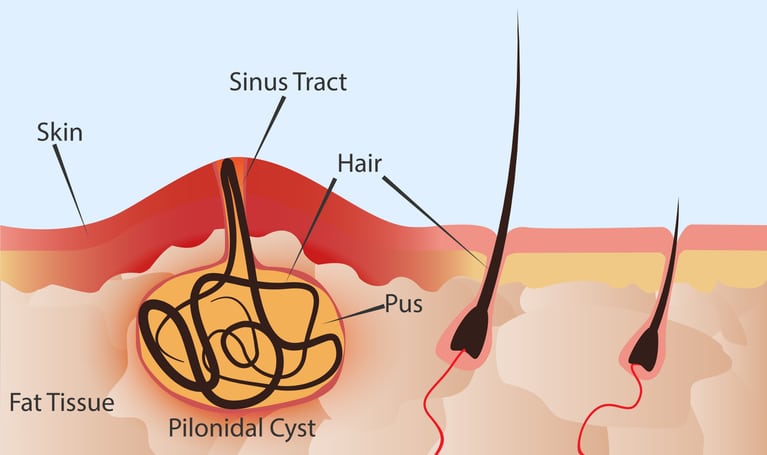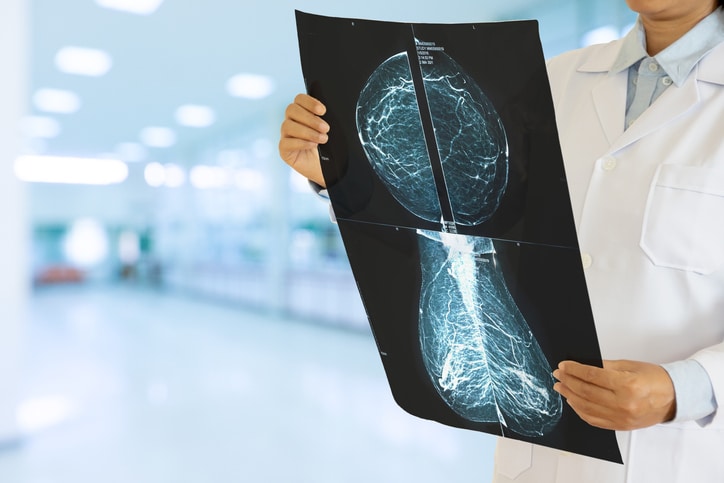One of the most common types of pilonidal cyst are the spherical, fluid, or air-filled cyst. The most common cause of a cyst in the buttocks crease is an infection in the skin. There are an estimated 70,000 new instances of pilonidal cysts in the United States each year. A pilonidal cyst is a benign growth on the skin that is usually packed with dead skin cells and hair. A pilonidal cyst is most often seen at the tailbone at the peak of the buttocks’ cleft. As a result of hair being embedded in the tissue underneath the skin, pilonidal cysts grow on it. If a pilonidal cyst abscess becomes infected, it may be quite painful. To drain the cyst, a little pilonidal cyst treatment may be performed, or it might be removed entirely. Pilonidal cysts are common, particularly in young men. Pilonidal cysts are more common in those who spend a lot of time sitting, such as truck drivers.
What is a pilonidal cyst?
Both forms of pilonidal cysts include air or fluid; the latter variety contains both. The most common cause of this kind of cyst in the buttocks crease is a skin infection. Each year, the United States receives over 70,000 reports of pilonidal cysts. It’s a pity that so many people are embarrassed to bring it up, not even with their physicians. It is possible that these cysts are painful and need medical care. A pilonidal cyst may be acute (short-term) in certain circumstances, while in others, it can be chronic (long-term). If pilonidal cyst treatment is ignored, chronic pilonidal cysts may develop into abscesses (infection-filled sacs) and sinus canals. Intergluteal pilonidal sickness or pilonidal cyst disease is a skin condition that arises anywhere between the tailbone and the anus and is known as intergluteal pilonidal disease. When you have this cyst, sitting down is almost impossible. These cysts, which often include ingrown hairs on the inside, are the consequence of an infection in the skin. Pilonidal cysts were termed “Jeep driver’s disease” because they were more common in those who sat a lot during WW2.
The following signs and symptoms are indicative of a pilonidal cyst
- Discomfort or tenderness
- Swelling
- Sense of tingling on the skin
- Cleaning a bodily cavity of pus or blood (sometimes with a foul smell)
What causes a pilonidal cyst?
We always get questions about “how does a pilonidal cyst form?”. There is no known etiology for pilonidal cysts. It was formerly thought that pilonidal cysts complications were congenital (a person was born with them), either because embryonic cells were in the wrong place at an early stage of development or because they were repeatedly traumatized (the “jeep driver’s disease”). According to current theories, a “sinus” or “pocket” is formed when dead skin cells and microorganisms are trapped within pores. Scar tissue may develop beneath the skin as a result of an abscess (subcutaneously). Due to its location above the buttock fold, a sacral dimple has been named. If the sacral dimple becomes irritated, a pilonidal cyst may occur.
Diagnosis of Pilonidal Cyst
The first step in diagnosing a pilonidal cyst is to have a doctor do a physical examination. Because of the build-up of pus in the buttock cleft, pilonidal cysts may cause pain or even bleeding (sinus). Because of its location towards the top of the buttocks, a pilonidal cyst is easily identified. If the infection is serious, a blood test might be used to provide a diagnosis. Imaging scans are seldom necessary for pilonidal cysts antibiotics.
Is it possible to cure a pilonidal cyst at home?
- Natural home remedies might help alleviate pain and swelling. Listed below are some instances of home remedies:
- It is possible that taking a warm bath and letting yourself relax may alleviate pain and possibly assist to prevent the development of an infection.
- Vitamin C and zinc supplements may aid in the healing process. Another advantage of vitamin A is that it aids in tissue repair. Before using any of these supplements, talk to your doctor.
- The use of essential oils such as tea tree or sage oil to aid with cyst healing is a viable option.
- Ingrown hairs may be avoided with the use of No Bump Rx.
- Castor oil may be massaged into the cyst to reduce irritation.
- Sitting with a coccyx pillow or cushion may help ease the pain in the lower back.
- There is some evidence that regular exercise might aid in the healing process.
Raw garlic may be applied directly to the cyst, however, it might irritate the skin and the open wound. Make sure to check with your doctor before taking any herbal supplement or natural remedy to determine if it might interact with any medications you are already taking. Following your doctor’s instructions is critical once a cyst has been drained and is now open.
Are pilonidal cysts common during pregnancy?
Despite the fact that pilonidal cysts treatments are more common in men, pregnant women may be at risk. Pregnancy-related buttock pain may be a sign of a pilonidal cyst, which is more serious than the typical discomfort. Typically, it’s a good idea to contact your service provider and have any issues resolved.
Pilonidal cysts are common. Is surgery necessary for my condition?
If your pilonidal cyst complications have expanded into a sinus cavity or have gotten infected, you might in the need of an operation to remove it entirely. Finally, a skin flap or gauze, or sutures may be placed into the wound to close it. After a surgical operation, proper wound care is vital to avoiding infection. If you have a wound, your doctor will give you thorough advice on how to clean and protect it. In addition, your healthcare provider may go through the signs and symptoms of an illness and when to get help.
Can this condition be treated?
There are certain pilonidal cysts that may be surgically treated, and the afflicted skin can be returned to normal. Even after the operation, a pilonidal cyst may return. Pilonidal cysts run in families, so if the disease has become worse, this is very important to know.
Prevention
Do The Following To Prevent Pilonidal Cysts:
- Clear the area of any dirt, and keep it clean.
- Lose weight if you need to.
- Avoid sitting for long periods of time.
If you’ve experienced pilonidal cysts in the past, shaving or using hair removal methods may be considered a preventative measure.





